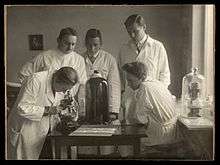Rhoda Erdmann

Rhoda Erdmann (5 December 1870 – 23 August 1935) was a German cell biologist.[1][2]
Erdmann was born in Hersfeld, Hesse[1] , a daughter of Dr. Heinrick E. Erdmann [3]. She received a Ph.D. in biology from the University of Munich in 1908 in the laboratory of Dr. Richard von Hertwig. Her thesis (Experimentelle Untersuchung der Massenverhältnisse von Plasma, Kern und Chromosomen in dem sich entwickelnden Seeigelei ",Experimental investigation of the mass ratios of plasma, nucleus and chromosomes in the developing sea urchin egg" ")[4] established her career as a protozoologist. She was one of the first women doctoral students in Germany, as women had only been allowed to pursue doctoral research in 1900. She then spent four years at the Institute for Infectious Diseases at the Robert Koch Institute and Charité Hospital of Berlin. Working with August von Wassermann, Erdmann attempted to develop vaccines against Cyanophilia viruses (now recognized at H7 High Pathogenicity Avian Influenza [5] ) in chickens[6]. As she was unable to secure a faculty position in Germany, she traveled to the U.S., where she became a research fellow at the Osborn Zoological Laboratory at Yale University. At Yale, she worked with Ross Granville Harrison, the noted developmental biologist on methods to propagate cells in vitro. From 1915 to 1918, she was a member of the Yale faculty. She also spent summers at the Rockefeller Institute, studying tissue culture techniques. Erdmann was able to successfully culture chicken bone marrow cells as part of her attempts to attenuate the cyanolophia virus. [7]. These studies were important for future work in hematology and virology. In addition, her work on the survival of Paramecium cultures led to important insights on cellular senescence and methods of genetic transmission [8] As a German citizen, she lost her position at Yale during World War I. Due to wartime hysteria, Erdmann was accused of poisoning the New Haven drinking water supply and introducing chicken cholera to the U.S in 1918.[9] She was jailed until February 1919 and returned to Germany later that year.[10]. In 1919, she established a department of experimental cell research at the Institute for Cancer Research, Charité teaching hospital in Berlin. She received faculty status in the Zoology department at the University of Berlin in 1920. She was appointed to the medical faculty at the University of Berlin in 1922 and promoted to Associate Professor with full civil service status. in 1929. She established the Institute of Experimental Cytology ( Institut für Experimentell Zellforschung) at Berlin University and served as its director. At the institute, she introduced tissue culture methods that she had learned in the U.S. Among her many contributions was the demonstration that cancer could be propagated by cell-free filtrates containing viruses [11] She was the first German woman to lead a university institute.[12] Erdmann also founded the periodical Archiv für experimentelle Zellforschung in 1925 and served as its editor until her death. She conceived the idea of an International Society for Experimental Cytology and served as its general secretary.[2] When the Nazis came to power in 1933, she was banned from laboratory work having been denounced by the eugenicist Henry Zeiss and the orthopedic surgeon Hermann Gocht as being Jewish. When this turned out to be untrue, she was accused of helping her Jewish students to secure positions and to emigrate[13] Her institute was closed and she was forced to retire.[10]. She was jailed in the spring of 1933 for two weeks by the Gestapo, but was released due to international pressure. However, in 1934 the German Government opened another institute for experimental cytology under her direction. She was active until her death, having recently completed a manuscript[14]
Erdmann died in Berlin[10]<ref> on August 24, 1935 at the age of 64 of a heart attack.[2]
References
- 1 2 "Rhoda Erdmann" (in German). Humboldt-Universität zu Berlin.
- 1 2 3 "Obituary" (PDF). The British Medical Journal. 2: 605. September 28, 1935. PMC 2461453. PMID 20779386.
- ↑ "Prof. A.M.R. Erdmann, Cancer Expert, Dies". New York times. August 26, 1935.
- ↑ "University Women's International Networks Database".
- ↑ Kaleta, Erhard; Rulke, Catherine (2008). The beginning of the spread of Fowl Plague (H7 High Pathogenicity Avian Influenza Virus) across Europe and Asia (1878-1955). Blackwell. pp. 145–190.
- ↑ Erdmann, Rhoda (1917). "Immunization against cyanolophia". Proc. Soc. Exptl. Biol and Med. 14: 156-161.
- ↑ Erdmann, Rhoda (1917). "cytological observations on the behavior of chicken bone marrow in plasma medium". American Journal of Anatomy. 22: 73-125.
- ↑ Erdmann, Rhoda (1918). "Endomixis and size variations in pure lines of Paramecium aurelia". Proc. Soc. Exptl. Biol. and Med. 16: 60-65.
- ↑ Maramorosch, Karl (2012). "The 3 Gs". Virologica Sinica. 27: 325.
- 1 2 3 "Erdmann, Rhoda". Encyclopedia of Life Sciences.
- ↑ Erdmann, Rhoa (1928). "Die Biologischen Eigenschaften der Krebszelle nach Erfanrungen der Explantations und Reimplantation". Ztschr. f. Krebsforsch. 27: 69.
- ↑ "Anna Maria Rhoda Erdmann". American Journal of Public Health. 10: 1171. 1935.
- ↑ "Philippstrasse 13, house 22". Humbdolt-Universitat Zu Berlin.
- ↑ "Prof. Rhoda Erdmann". Nature. 136: 672. 1935.
External links